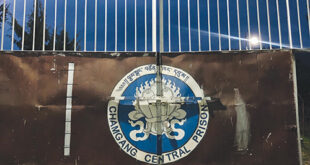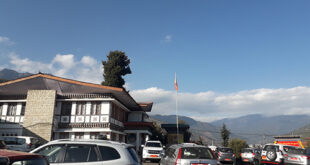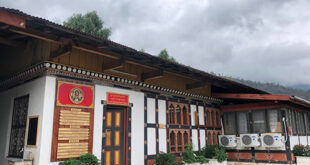The Pay Commission report and the Pay Revision report proposals to monetize the quota at Nu 160,000 have been dropped by the govt
In what will be music to the ears of more than 3,000 eligible civil servants, the government has decided to lift the vehicle quota freeze imposed in April 2012.
This will mean that eligible civil servants importing a vehicle will be exempt from Custom Duties and Sales Tax up to Nu 800,000 of the car’s value.
This would mean that if an eligible civil servant buys a car worth Nu 800,000 then he or she will not have to pay any custom duty or sales tax. If the car is worth Nu 1.6 mn then half the amount or Nu 800,000 will be tax free and tax will only have to be paid on the remaining Nu 800,000 that exceeds the quota bracket.
The Finance Minister Lyonpo Namgay Dorji said, “The government originally wanted to remove vehicle quotas for everyone from MPs to Civil Servants, but since MPs opted to keep their vehicle quota as per the Entitlement Act then the government felt it would only be fair to also give civil servants their quota.”
Lyonpo said the government also took this decision keeping in mind the need to keep civil servants motivated as a vehicle quota was one of the very few perks that a civil servant enjoyed.
Currently as per the Vehicle Quota Rules of 2009 any public servant or civil servant from the grade of P3A and above are eligible for the civil service vehicle quota.
The Finance Minister said that the Pay Commission report had originally recommended doing away with the vehicle quota for all categories of public servants from MPs to Civil Servants and instead giving Nu 160,000 every seven years.
He said the government’s Pay Revision report presented in the Parliament also stated the same point as the government also completely wanted to remove vehicle quotas and instead monetize them.
Lyonpo pointed out that the problem was not with the quota but its misuse by some who sold the quota and with the profit imported another vehicle resulting in the import of two vehicles from one quota.
The Minister said, “When I consulted the ruling party MPs they were ready to also give up their vehicle quota but since they are equated at the level of a Secretary they in place of the quota requested a government chauffer driven vehicle that Secretaries also get.”
The Minister said that he communicated to the MPs at the time that this would not be possible as the long term costs to the government would be much more than even the quotas.
The minister said that finally with the MPs in Parliament not agreeing to monetize the quota for themselves the government decided that it would do the same for civil servants as well.
With many under the impression that the Parliament had not discussed or deferred the vehicle quota discussion to the winter session the finance minister said that this was not the case.
“The National Assembly resolution states that the Vehicle Quota issues is actually a policy issue with existing rules in place and that the government of the day should take a decision and so the government has accordingly taken a decision,” said the minister.
The immediate beneficiary would be more than 3,000 or so civil servants who are eligible but the actual numbers could even be higher.
Since 2006 till 2012 before the ban, 3,478 quotas were allotted of which 1,571 are yet to be used (see box). There are also 437 new applicants since the quota suspension came into place from April 2012 onwards. This would mean that there are already 2,008 civil servants who are registered.
According to the Finance Ministry there are around 600 to 700 eligible applicants a year for the vehicle quota. For example 797 quotas were allotted in 2011. With many not bothering to apply after the early 2012 ban the actual eligible numbers could well surpass 3,000 civil servants.
The minister said that the Finance Ministry was in the final stages of amending a few Quota rules to bring it up to date, but he said that it would not affect that main fact that civil servants would be eligible to a quota after every seven years and that the eligible tax free amount would be Nu 800,000.
However, the finance minister also clarified that the government will also study and find out why people who applied for and were allotted quotas between 2006 and 2009 did not use them.
If the original idea of monetizing vehicle quotas were followed the immediate financial impact on the government could have been quite substantial. For example according to the MoF just monetizing the 1,571 allotted but unused quotas would have cost the government Nu 251.36 mn not to mention the other pending quotas. If it was done for more than 3,000 quotas then the cost would have well crossed Nu 500 mn for the government though it would have come down in the following years.
The Pay Commission report showed that from 2000 to 2013 there were 2,115 allotted but unused quotas and it projected around 730 applicants in 2014. The report said that for 2,115 quotas the tax revenue foregone was Nu 930.60 mn but the Nu 160,000 cash compensation would be Nu 338.40 mn.
The vehicle quota suspension was the result of a series of measures taken in early 2012 to deal with the rupee crisis which hit from late 2011 onwards.
The former government on January 2012 came up with a high level committee to study the rupee problem and possible solutions. The report submitted in March 2012 among many measures recommended doing away with the Civil Service vehicle quota saying that from 2002 to 2011 the government had given up on Nu 900 mn in taxes due to the quota.
It also pointed out that in the same period 3,121 vehicles worth Nu 2.596 bn were imported under the quota. The report said that the quota had a huge impact on rupee and convertible currency outflows and also import of fuel. It also said that quotas resulted in import of two cars due to the profit from selling one quota.
With vehicle taxes hiked from 55 percent to 180 percent the vehicle quotas would be more valuable and also allow civil servants to save more money in importing vehicles.
 The Bhutanese Leading the way.
The Bhutanese Leading the way.



